Day 2 of a four day Autumn Tour in Norfolk. In contrast to yesterday, it was a bright sunny start, although it did cloud over again late morning and there were then one or two sharp showers in the afternoon. There was a rather brisk SW wind too.
Our destination for the morning was Holkham. As we parked at Lady Anne’s Drive, we could see hundreds of Pink-footed Geese coming up over the pines to the east, presumably coming in from the mudflats beyond Wells. They came over calling as we were getting ready, we could hear their distinctive yelping calls.
A couple of Grey Herons on the edge of the reeds out on the grazing marsh to the west were new birds for the trip list. As we walked up towards the pines, a Song Thrush was catching the sunshine in one of the hawthorns on the edge of the grass, possibly a migrant from the continent warming up.
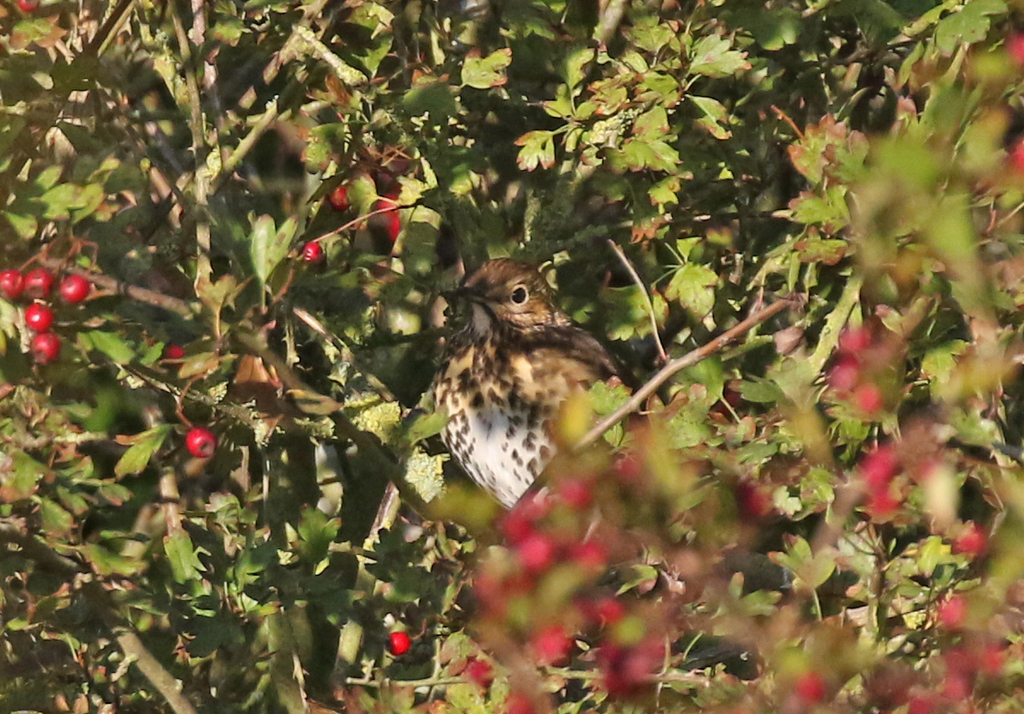
As we walked west along the track on the south side of the pines, we could hear a Chiffchaff calling. One or two Jays flew back and forth across the track between the pines and the poplars.
We stopped to watch several Goldcrests feeding low down in the bushes beside the path. We would see quite a few of them along here this morning. Although they breed here, numbers are swelled in autumn by migrants arriving from the continent. Amazing to think that such tiny birds, which weigh about as much as a 20p coin, can make it all the way here across the North Sea.

Just before we got to Salts Hole, we noticed some movement in the leaves in a small oak tree by the track. It was a Redwing, another fresh arrival from the continent, coming here from Scandinavia for the winter. Unfortunately it disappeared deeper into the trees before we could all get a look at it – but we would see several more over the coming days.
At Salts Hole, there were at least six Little Grebes around the pool, along with plenty of Mallards. Out of the shelter of the trees, it was now much breezier than we had expected – it had seemed much calmer when we had got out of the minibus at Lady Anne’s Drive earlier, so perhaps the wind had picked up since.
As we walked up onto the boardwalk by Washington Hide, we could hear Long-tailed Tits in the sycamores beyond. We carried on past the hide to see if we could find anything with them. There were Blue Tits and Great Tits, a Coal Tit calling, and several more Goldcrests, but there was nothing rarer with them today.
We carried on to the end of the boardwalk and had a quick look out at the beach. It was a great view, looking out over the dunes in the sunshine. It was more sheltered this side of the pines, but quiet.
Back to the hide, it is still nailed shut, so we stood on the boardwalk to look out over the marshes. There was a small flock of geese on the grass, mainly Pink-footed Geese but we could see a couple of Greylags in with them. We got them in the scopes, a nice comparison of the two species side by side.
At Meals House, we had a quick look in the garden but it was all quiet, apart from a Pied Wagtail calling from the house. A Common Buzzard was hanging in the air above our heads over the pines just beyond. It was a good morning for raptors, sunny with a fresh breeze, and the Buzzard was enjoying the updraft of the wind hitting the trees.
We thought there might some more activity in the trees either side of the crosstracks, particularly given some shelter from the wind here, but it was quiet here too as we walked past. A Chiffchaff was calling from the bushes before the crosstracks. We could hear tits as we walked through the pines but they were deep in the trees where there is currently no access due to forestry work.
Contintuing west, a small group of Siskins flew over calling and another Chiffchaff flicked out of the sallows and across the path. When we got to the gate at the west end of the pines, we stopped to scan the grazing marshes. A Blackcap was calling in the brambles.
Looking towards the dunes, we noticed a Red Kite coming straight towards us along the end of the pines. It hung in the air overhead circling, then drifted back behind the trees. When it came back out again, it was joined by three more Red Kites. We watched the four of them circling together, in the updraft on the edge of the trees, before they drifted back and we lost sight of them again.
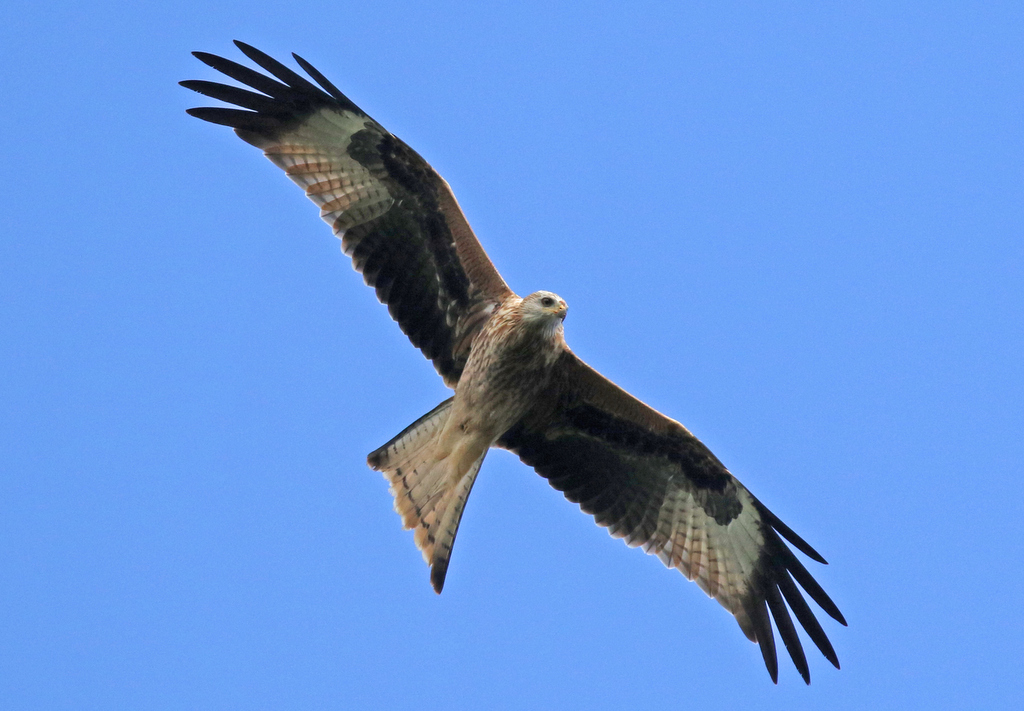
A minute or so later, the Red Kites flew out over the west end of the pines further back and we watched as they headed off over the dunes. As they disappeared off west, it seemed like some of them might be on the move today.
Continuing round through the trees, we made our way out into the edge of the dunes, into one of the bramble-lined hollows. There had been a Barred Warbler here a couple of days ago, but there was no report of it yesterday. We thought there had to be a good chance it might still be here, but the bushes in the first hollow were quiet, not even any sign of any Blackcaps.
Back out onto the path, we walked up onto the higher dunes to scan the grazing marshes. A couple of Stonechats appeared on the brambles down by the fence below us and a Blackcap popped up in the top of the bushes further back.
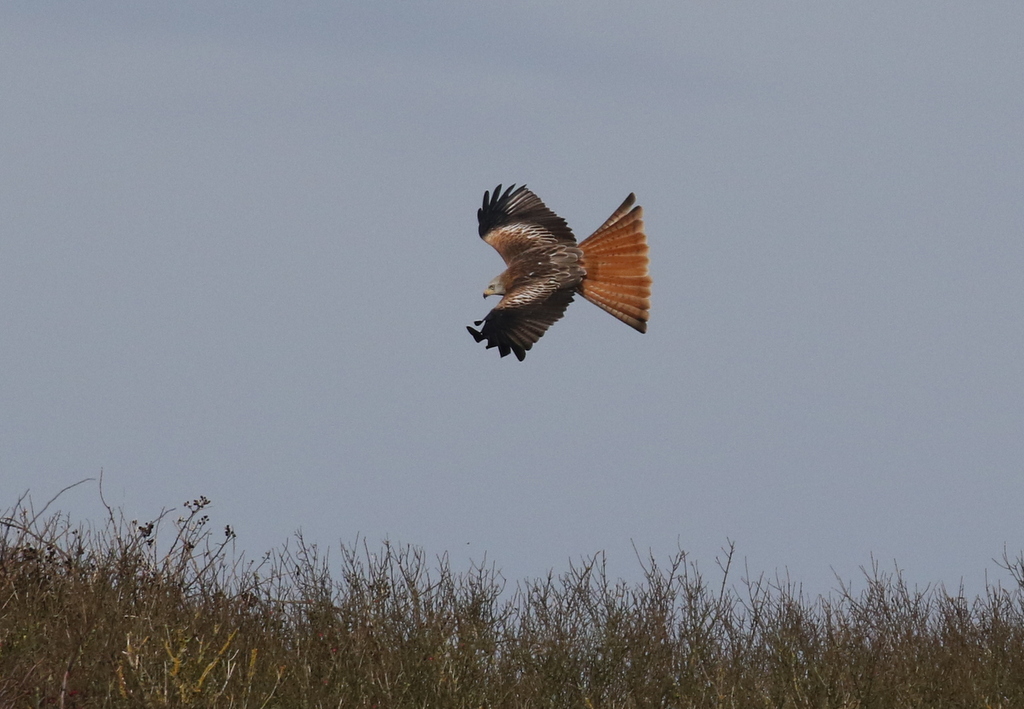
One of the Red Kites drifted back over the dunes towards us, and started circling over the highest point. It kept swooping down at something on the ground. It was a smart adult and its red tail shone in the morning sun as it twisted and turned. A Magpie appeared and started harrying it, swooping down at it.

It was warming up now, and three Common Buzzards circled up over the middle of the grazing marshes. We could see a large herd of cows in the top corner of the fields and several white shapes in the grass in amongst them. Through the scopes, we could see they were the Cattle Egrets. We could only see two at first, but gradually more appeared from behind the cows and we got up to at least seven by the end. Looking the other way, towards Decoy Wood, we found at least three Great White Egrets too.
There were more Blackcaps calling from the bushes behind us now, so we walked round the back to look in the dune slacks. As we walked round through the bushes, we heard Bullfinches calling quietly, and three flew out and disappeared into the brambles the other side.
As we climbed over the top of the dunes, we flushed two Blackcaps out from the brambles below the ridge. They were immediately followed by a larger, greyer warbler – the Barred Warbler! All three birds flew across the hollow and into the bushes on the far side. We stopped on the top and looked across and after a minute the Barred Warbler reappeared.
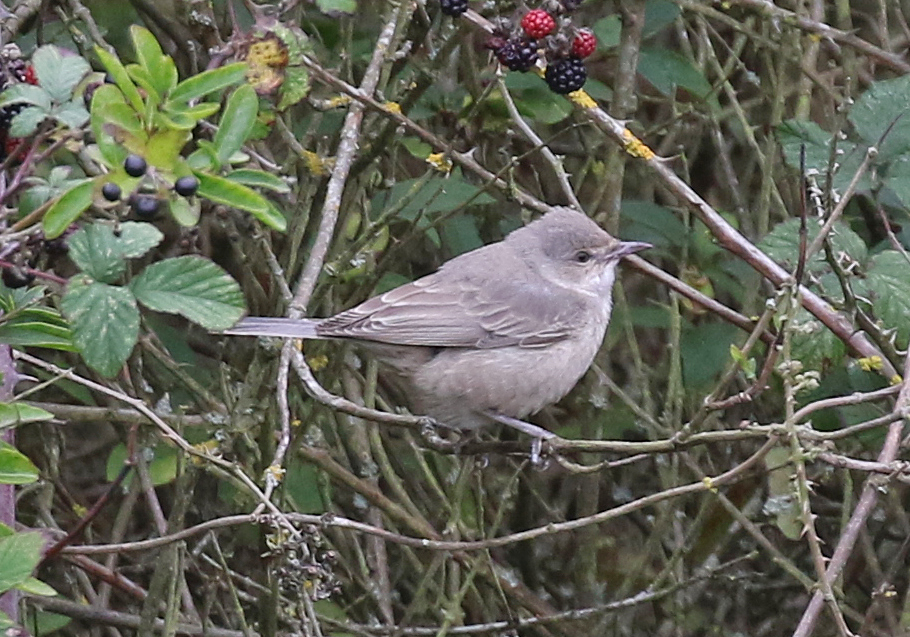
We watched the Barred Warbler for some time. It kept disappearing into the brambles, before re-emerging again a little further round. We got it in the scope and had a great view, as it fed on blackberries. It was a juvenile – lacking the heavy barring underneath shown by adult males (and to a lesser extent by females), but still with a ghosting of crescents on its flanks and undertail.
Barred Warblers are scarce autumn visitors here, on their way from their breeding grounds in Eastern Europe to Africa for the winter, so a great bird to see. When it disappeared, we walked round to the path on the other side of the hollow, and as we came out from behind some trees, the Barred Warbler flicked out ahead of us again. We had seen another group emerge from the end of the pines, so we called them over and pointed out the bushes where it had gone in.
With our main target achieved, we set off to walk back. We were almost back to the crosstracks, when a tit flock came out of the sallows and across the track ahead of us. The Long-tailed Tits were followed by loads of Goldcrests, but they didn’t linger and disappeared quickly back up into the pines.
We heard a Yellow-browed Warbler call from somewhere a little further along the track. It didn’t seem to be with the tits, so we walked round on the path behind the sallows, hoping to relocate. Unfortunately, it had gone quiet now and the trees are very thick here, lots of places to hide. Another Redwing came in high over the pines.
On the other side of the crosstracks, we had to pick our way through the mud where the path had been churned up by the forestry work. Just as we arrived where they were working, we thought we heard another Yellow-browed Warbler call, but their was lots of noise coming from a huge vehicle driving through the edge of the trees. We had to wait for the vehicle to come out of the trees, and the driver to turn it off to go for lunch.
We heard the Yellow-browed Warbler call again a couple of times, but it was now further back the way we had just come, towards the crosstracks. We had to pick our way back through all the mud. We got out into the open area beyond just in time to catch the back end of a tit flock coming out of the trees. They were moving fast now, but we tried to follow them along one of the paths through the reeds.
The trail seemed to have gone cold, but as just as the flock disappeared back towards Bones Drift, the Yellow-browed Warbler started calling again. It was calling much more persistently this time, but we couldn’t follow it as there was a forestry work barrier across the path and we couldn’t see it in the trees in the distance.
It was quiet on the rest of the walk back, and when we got back to the top of Lady Anne’s Drive, we headed into the Lookout to get a hot drink and stop for lunch. After lunch, we drove round to Wells beach car park, to spend the afternoon there in the woods.
As we walked in past the boating lake, there were lots of Little Grebes and several Coot out on the water, along with four Tufted Ducks, a new bird for the trip list. We made our way in through the birches and it seemed rather quiet in the trees until we got round to the north side of the Dell and found a tit flock. Unfortunately, it was on the move already and everything came quickly straight out of the Dell and disappeared high into the pines before we could get a chance to look through.
We headed back out and cross the main track, into the open area to the south. Over on the far side, we stopped to scan the grazing marshes as the sun came out. There were several Pied Wagtails flitting around out in the wet grass, and a scattering of Curlews and Lapwing around the pools.
Four Red Kites came up together in the sunshine, joined by a Marsh Harrier which drifted off west. Some people told us there had been a large falcon around earlier too and something still seemed to be spooking all the ducks, Lapwings and Black-tailed Godwits over on the marshes further back beyond the reeds. We couldn’t see anything now, so perhaps it was just that they were still nervous after its earlier visit.
Continuing on round through the bushes, we found several Redwings in the hawthorns in the reeds over in the far corner, and finally got better views of one or two here. We flushed two or three Blackcaps from the brambles along with a grey continental Robin. A small flock of Goldfinches flew over with a couple of Lesser Redpoll, calling.
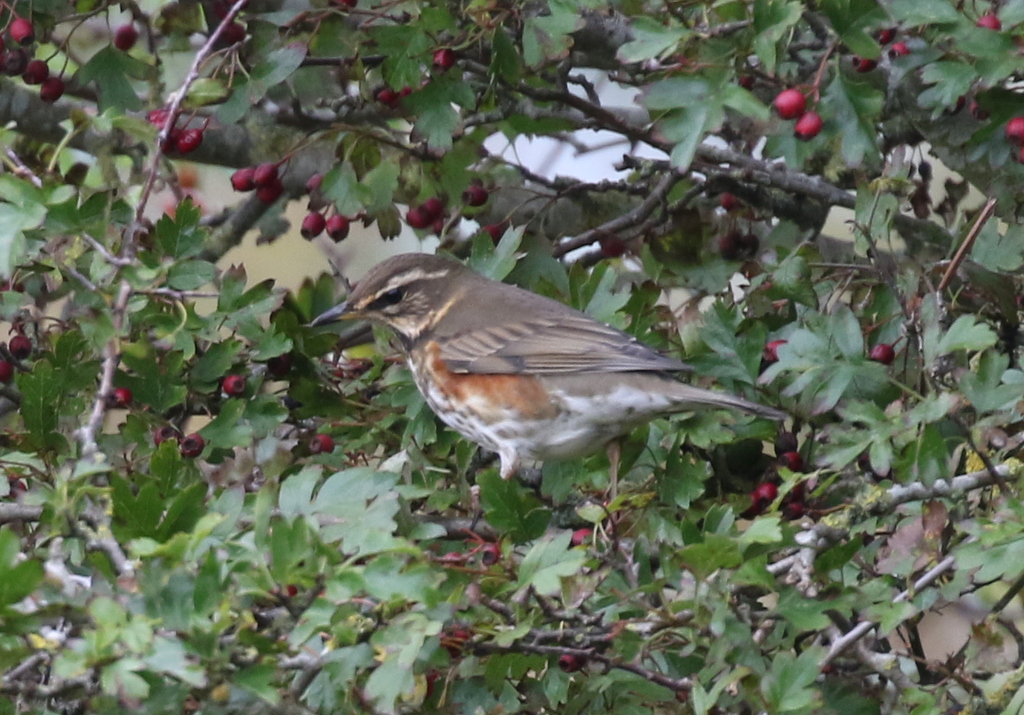
Back out on the main track, we continued on west. We cut in round via the Drinking Pool but despite having refilled with water after the recent rains it was very quiet here now. We hadn’t got much further along the track when it started to rain. We made our way in to the trees where it was more sheltered, and thankfully it eased quickly and then stopped.
We made our way back and decided to go to look for the Red-backed Shrike which was apparently still feeding around the fields to the south. As we started down the track beside the caravan site, we found another tit flock in the trees on the corner. We followed it down the line of the shelter belt, beside the track, but we couldn’t find anything different with the tits here either, despite getting a better look through the flock this time. There were lots of ducks out on Quarles Marsh opposite, Wigeon, Teal and a few Mallard.
We could see more dark clouds approaching and it started to rain again now, more heavily. We got to where the shrike had been, but were told it had disappeared earlier when the rain started. We scanned along the line of bushes on the edge of the ditch where it was last seen, but there was nothing moving in there now. We could see lots of Pied Wagtails in the field in front of us and a big flock of Skylarks and Linnets came up from the next field over.
It was very exposed out here, in the rain. We could see brighter skies approaching and figured the sun would be back out in about half an hour, so we decided to head back to the Dell, and the shelter of trees, and have another look here afterwards.
When we got back up to the main track, we turned right to head to the east side of the Dell and were just walking along beside the back of the boating lake when we heard Long-tailed Tits. We stopped and turned to see a tit flock coming out of the caravan park into the trees by the track.
The Long-tailed Tits started to fly across the track one by one and then a small bird flew across behind them. It flew up into a nearby sallow and a quick look confirmed it was a Yellow-browed Warbler. Finally we had a good prolonged view of it, as it flicked around in the bush.
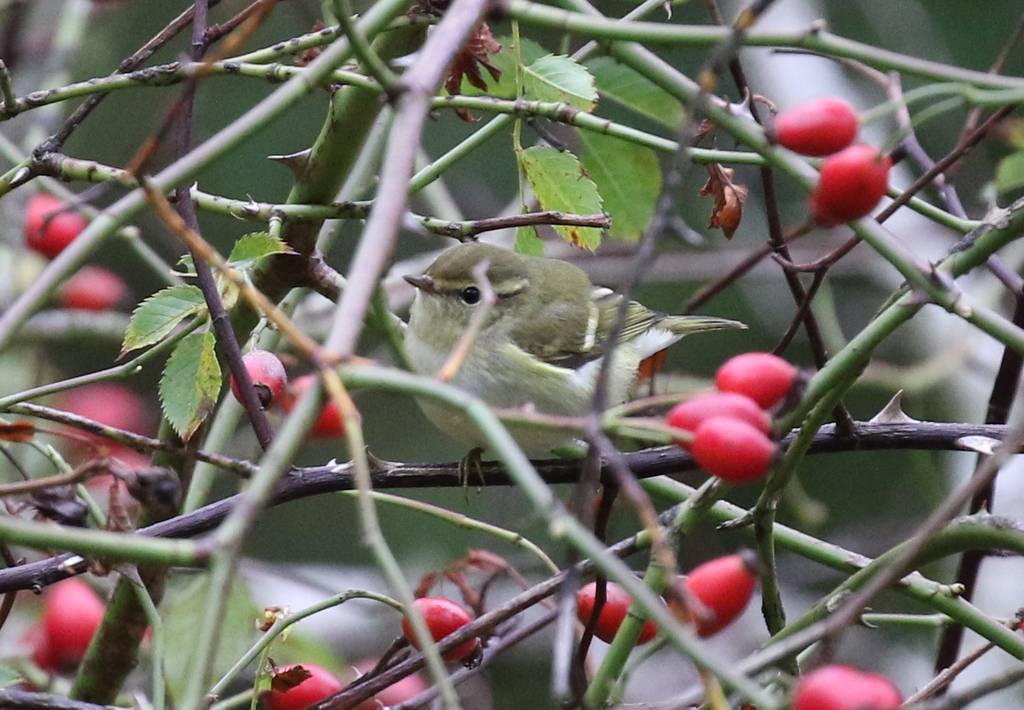
Then the Long-tailed Tits set off through the trees around the east side of the Dell, and everything else followed. We set off after them too, and managed to keep up with them for a while. There were a few Goldcrests with them as well and a Chiffchaff. We had a couple more brief views of the Yellow-browed Warbler before we lost the flock in the trees.
It had stopped raining now, and with our other main target here now in the bag, we made our way back round the edge of the Dell through the trees. We heard Brambling and Lesser Redpoll calling overhead as we made our way back to the main track, before heading back down to have another look for shrike. Several people were now leaving, but despite one claim, there didn’t really appear to have been any further sign of it.
The weather was now much improved, so we walked down the track beside the ditch where it had been earlier to look in the bushes at the far end. There were lots of Linnets and Reed Buntings along the sides of the ditches but at the far end all we found was a Sparrowhawk which flew fast and low over the fields and disappeared towards Wells.
Back at the junction, we stopped to look at some Grey Partridges out on one of the cut grass fields. There were still a couple of people here looking for the shrike, but there was still no further sign of it. Perhaps it had gone in to roost early when the rain came? The forecast for the morning looked good, so we decided to have another go early tomorrow. Time to call it a day today.
















